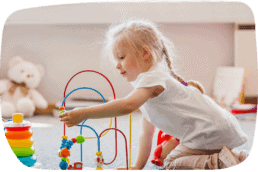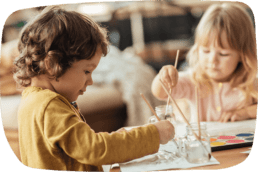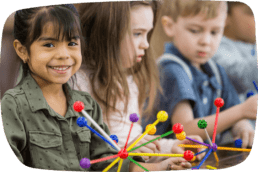Infants

0-12 months
Toddler

1-3 years
Preschool

4-5 years
Flex-Care

Parent Support
Infants

0-12 months
Toddler

1-3 years
Preschool

4-5 years
Flex-Care

Parent Support
CDC’s Developmental Milestones
What most babies do by this age:
How your child plays, learns, speaks, acts, and moves offers important clues about your child’s development. Developmental milestones are things most children can do by a certain age.
Social and Emotional
- Begins to smile at people
- Can briefly calm herself (may bring hands to mouth and suck on hand)
- Tries to look at parent
Language/Communication
- Coos, makes gurgling sounds
- Turns head toward sounds
Cognitive (learning, thinking, problem-solving)
- Pays attention to faces
- Begins to follow things with eyes and recognize people at a distance
- Begins to act bored (cries, fussy) if activity doesn’t change
Movement/Physical Development
- Can hold head up and begins to push up when lying on tummy
- Makes smoother movements with arms and legs
Act early by talking to your child’s doctor if your child:
- Doesn’t respond to loud sounds
- Doesn’t watch things as they move
- Doesn’t smile at people
- Doesn’t bring hands to mouth
- Can’t hold head up when pushing up when on tummy
What most babies do by this age:
How your child plays, learns, speaks, acts, and moves offers important clues about your child’s development. Developmental milestones are things most children can do by a certain age.
Social and Emotional
- Knows familiar faces and begins to know if someone is stranger
- Likes to play with others, especially parents
- Responds to other people’s emotions and often seems happy
- Likes to look at self in a mirror
Language/Communication
- Responds to sounds by making sounds
- Strings vowels together when babbling (“ah,” “eh,” “oh”) and likes taking turns with parent while making sounds
- Responds to own name
- Makes sounds to show joy and displeasure
- Begins to say consonant sounds (jabbering with “m,” “b”)
Cognitive (learning, thinking, problem-solving)
- Looks around at things nearby
- Brings things to mouth
- Shows curiosity about things and tries to get things that are out of reach
- Begins to pass things from one hand to the other
Movement/Physical Development
- Rolls over in both directions (front to back, back to front)
- Begins to sit without support
- When standing, supports weight on legs and might bounce
- Rocks back and forth, sometimes crawling backward before moving forward
Act early by talking to your child’s doctor if your child:
- Doesn’t try to get things that are in reach
- Shows no affection for caregivers
- Doesn’t respond to sounds around him
- Has difficulty getting things to mouth
- Doesn’t make vowel sounds (“ah”, “eh”, “oh”)
- Doesn’t roll over in either direction
- Doesn’t laugh or make squealing sounds
- Seems very stiff, with tight muscles
- Seems very floppy, like a rag doll
What most babies do by this age:
How your child plays, learns, speaks, acts, and moves offers important clues about your child’s development. Developmental milestones are things most children can do by a certain age.
Social and Emotional
- May be afraid of strangers
- May be clingy with familiar adults
- May be clingy with familiar adults
Language/Communication
- Understands “no”
- Makes a lot of different sounds like “mamamama” and “bababababa”
- Copies sounds and gestures of others
- Uses fingers to point at things
Cognitive (learning, thinking, problem-solving)
- Watches the path of something as it falls
- Looks for things she sees you hide
- Plays peek-a-boo
- Puts things in his mouth
- Moves things smoothly from one hand to the other
- Picks up things like cereal o’s between thumb and index finger
Movement/Physical Development
- Stands, holding on
- Can get into sitting position
- Sits without support
- Pulls to stand
- Crawls
Act early by talking to your child’s doctor if your child:
- Doesn’t bear weight on legs with support
- Doesn’t sit with help
- Doesn’t babble (“mama”, “baba”, “dada”)
- Doesn’t play any games involving back-and-forth play
- Doesn’t respond to own name
- Doesn’t seem to recognize familiar people
- Doesn’t look where you point
- Doesn’t transfer toys from one hand to the other
What most children do by this age:
How your child plays, learns, speaks, acts, and moves offers important clues about your child’s development. Developmental milestones are things most children can do by a certain age.
Social and Emotional
- Is shy or nervous with strangers
- Cries when mom or dad leaves
- Has favorite things and people
- Shows fear in some situations
- Hands you a book when he wants to hear a story
- Repeats sounds or actions to get attention
- Puts out arm or leg to help with dressing
- Plays games such as “peek-a-boo” and “pat-a-cake”
Language/Communication
- Responds to simple spoken requests
- Uses simple gestures, like shaking head “no” or waving “bye-bye”
- Makes sounds with changes in tone (sounds more like speech)
- Says “mama” and “dada” and exclamations like “uh-oh!”
- Tries to say words you say
Cognitive (learning, thinking, problem-solving)
- Explores things in different ways, like shaking, banging, throwing
- Finds hidden things easily
- Looks at the right picture or thing when it’s named
- Copies gestures
- Starts to use things correctly; for example, drinks from a cup, brushes hair
- Bangs two things together
- Puts things in a container, takes things out of a container
- Lets things go without help
- Pokes with index (pointer) finger
- Follows simple directions like “pick up the toy”
Movement/Physical Development
- Gets to a sitting position without help
- Pulls up to stand, walks holding on to furniture (“cruising”)
- May take a few steps without holding on
- May stand alone
Act early by talking to your child’s doctor if your child:
- Doesn’t crawl
- Can’t stand when supported
- Doesn’t search for things that she sees you hide
- Doesn’t say single words like “mama” or “dada”
- Doesn’t learn gestures like waving or shaking head
- Doesn’t point to things
- Loses skills he once had
What most babies do by this age:
How your child plays, learns, speaks, acts, and moves offers important clues about your child’s development. Developmental milestones are things most children can do by a certain age.
Social and Emotional
- Likes to hand things to others as play
- May have temper tantrums
- May be afraid of strangers
- Shows affection to familiar people
- Plays simple pretend, such as feeding a doll
- May cling to caregivers in new situations
- Points to show others something interesting
- Explores alone but with parent close by
Language/Communication
- Says several single words
- Says and shakes head “no”
- Points to show someone what he wants
Cognitive (learning, thinking, problem-solving)
- Knows what ordinary things are for; for example, telephone, brush, spoon
- Points to get the attention of others
- Shows interest in a doll or stuffed animal by pretending to feed
- Points to one body part
- Scribbles on his own
- Can follow 1-step verbal commands without any gestures; for example, sits when you say “sit down”
Movement/Physical Development
- Walks alone
- May walk up steps and run
- Pulls toys while walking
- Can help undress herself
- Drinks from a cup
- Eats with a spoon
Act early by talking to your child’s doctor if your child:
- Doesn’t point to show things to others
- Can’t walk
- Doesn’t know what familiar things are for
- Doesn’t copy others
- Doesn’t gain new words
- Doesn’t have at least 6 words
- Doesn’t notice or mind when a caregiver leaves or returns
- Loses skills he once had
What most babies do by this age:
How your child plays, learns, speaks, acts, and moves offers important clues about your child’s development. Developmental milestones are things most children can do by a certain age.
Social and Emotional
- Copies others, especially adults and older children
- Gets excited when with other children
- Shows more and more independence
- Shows defiant behavior (doing what he has been told not to)
- Plays mainly beside other children, but is beginning to include other children, such as in chase games
Language/Communication
- Points to things or pictures when they are named
- Knows names of familiar people and body parts
- Says sentences with 2 to 4 words
- Follows simple instructions
- Repeats words overheard in conversation
- Points to things in a book
Cognitive (learning, thinking, problem-solving)
- Finds things even when hidden under two or three covers
- Begins to sort shapes and colors
- Completes sentences and rhymes in familiar books
- Plays simple make-believe games
- Builds towers of 4 or more blocks
- Might use one hand more than the other
- Follows two-step instructions such as “Pick up your shoes and put them in the closet.”
- Names items in a picture book such as a cat, bird, or dog
Movement/Physical Development
- Stands on tiptoe
- Kicks a ball
- Begins to run
- Climbs onto and down from furniture without help
- Walks up and down stairs holding on
- Throws ball overhand
- Makes or copies straight lines and circles
Act early by talking to your child’s doctor if your child:
- Doesn’t use 2-word phrases (for example, “drink milk”)
- Doesn’t know what to do with common things, like a brush, phone, fork, spoon
- Doesn’t copy actions and words
- Doesn’t follow simple instructions
- Doesn’t walk steadily
- Loses skills she once had
What most children do by this age:
How your child plays, learns, speaks, acts, and moves offers important clues about your child’s development. Developmental milestones are things most children can do by a certain age.
Social and Emotional
- Copies adults and friends
- Shows affection for friends without prompting
- Takes turns in games
- Shows concern for crying friend
- Understands the idea of “mine” and “his” or “hers”
- Shows a wide range of emotions
- Separates easily from mom and dad
- May get upset with major changes in routine
- Dresses and undresses self
Language/Communication
- Follows instructions with 2 or 3 steps
- Can name most familiar things
- Understands words like “in,” “on,” and “under”
- Says first name, age, and sex
- Names a friend
- Says words like “I,” “me,” “we,” and “you” and some plurals (cars, dogs, cats)
- Talks well enough for strangers to understand most of the time
- Carries on a conversation using 2 to 3 sentences
Cognitive (learning, thinking, problem-solving)
- Can work toys with buttons, levers, and moving parts
- Plays make-believe with dolls, animals, and people
- Does puzzles with 3 or 4 pieces
- Understands what “two” means
- Copies a circle with pencil or crayon
- Turns book pages one at a time
- Builds towers of more than 6 blocks
- Screws and unscrews jar lids or turns door handle
Movement/Physical Development
- Climbs well
- Runs easily
- Pedals a tricycle (3-wheel bike)
- Walks up and down stairs, one foot on each step
Act early by talking to your child’s doctor if your child:
- Falls down a lot or has trouble with stairs
- Drools or has very unclear speech
- Can’t work simple toys (such as peg boards, simple puzzles, turning handle)
- Doesn’t speak in sentences
- Doesn’t understand simple instructions
- Doesn’t play pretend or make-believe
- Doesn’t want to play with other children or with toys
- Doesn’t make eye contact
- Loses skills he once had
What most children do by this age:
How your child plays, learns, speaks, acts, and moves offers important clues about your child’s development. Developmental milestones are things most children can do by a certain age.
Social and Emotional
- Enjoys doing new things
- Plays “Mom” and “Dad”
- Is more and more creative with make-believe play
- Would rather play with other children than by himself
- Cooperates with other children
- Often can’t tell what’s real and what’s make-believe
- Talks about what she likes and what she is interested in
Language/Communication
- Knows some basic rules of grammar, such as correctly using “he” and “she”
- Sings a song or says a poem from memory such as the “Itsy Bitsy Spider” or the “Wheels on the Bus”
- Tells stories
- Can say first and last name
Cognitive (learning, thinking, problem-solving)
- Names some colors and some numbers
- Understands the idea of counting
- Starts to understand time
- Remembers parts of a story
- Understands the idea of “same” and “different”
- Draws a person with 2 to 4 body parts
- Uses scissors
- Starts to copy some capital letters
- Plays board or card games
- Tells you what he thinks is going to happen next in a book
Movement/Physical Development
- Hops and stands on one foot up to 2 seconds
- Catches a bounced ball most of the time
- Pours, cuts with supervision, and mashes own food
Act early by talking to your child’s doctor if your child:
- Can’t jump in place
- Has trouble scribbling
- Shows no interest in interactive games or make-believe
- Ignores other children or doesn’t respond to people outside the family
- Resists dressing, sleeping, and using the toilet
- Can’t retell a favorite story
- Doesn’t follow 3-part commands
- Doesn’t understand “same” and “different”
- Doesn’t use “me” and “you” correctly
- Speaks unclearly
- Loses skills he once had
What most babies do by this age:
How your child plays, learns, speaks, acts, and moves offers important clues about your child’s development. Developmental milestones are things most children can do by a certain age.
Social and Emotional
- Smiles spontaneously, especially at people
- Likes to play with people and might cry when playing stops
- Copies some movements and facial expressions, like smiling or frowning
Language/Communication
- Begins to babble
- Babbles with expression and copies sounds he hears
- Cries in different ways to show hunger, pain, or being tired
Cognitive (learning, thinking, problem-solving)
- Lets you know if he is happy or sad
- Responds to affection
- Reaches for toy with one hand
- Uses hands and eyes together, such as seeing a toy and reaching for it
- Follows moving things with eyes from side to side
- Watches faces closely
- Recognizes familiar people and things at a distance
Movement/Physical Development
- Holds head steady, unsupported
- Pushes down on legs when feet are on a hard surface
- May be able to roll over from tummy to back
- Can hold a toy and shake it and swing at dangling toys
- Brings hands to mouth
- When lying on stomach, pushes up to elbows
Act early by talking to your child’s doctor if your child:
- Doesn’t watch things as they move
- Doesn’t smile at people
- Can’t hold head steady
- Doesn’t coo or make sounds
- Doesn’t bring things to mouth
- Doesn’t push down with legs when feet are placed on a hard surface
- Has trouble moving one or both eyes in all directions
What most children do by this age:
How your child plays, learns, speaks, acts, and moves offers important clues about your child’s development. Developmental milestones are things most children can do by a certain age.
Social and Emotional
- Wants to please friends
- Wants to be like friends
- More likely to agree with rules
- Likes to sing, dance, and act
- Is aware of gender
- Can tell what’s real and what’s make-believe
- Shows more independence (for example, may visit a next-door neighbor by himself [adult supervision is still needed])
- Is sometimes demanding and sometimes very cooperative
Language/Communication
- Speaks very clearly
- Tells a simple story using full sentences
- Uses future tense; for example, “Grandma will be here.”
- Says name and address
Cognitive (learning, thinking, problem-solving)
- Counts 10 or more things
- Can draw a person with at least 6 body parts
- Can print some letters or numbers
- Copies a triangle and other geometric shapes
- Knows about things used every day, like money and food
Movement/Physical Development
- Stands on one foot for 10 seconds or longer
- Hops; may be able to skip
- Can do a somersault
- Uses a fork and spoon and sometimes a table knife
- Can use the toilet on her own
- Swings and climbs
Act early by talking to your child’s doctor if your child:
- Doesn’t show a wide range of emotions
- Shows extreme behavior (unusually fearful, aggressive, shy or sad)
- Unusually withdrawn and not active
- Is easily distracted, has trouble focusing on one activity for more than 5 minutes
- Doesn’t respond to people, or responds only superficially
- Can’t tell what’s real and what’s make-believe
- Doesn’t play a variety of games and activities
- Can’t give first and last name
- Doesn’t use plurals or past tense properly
- Doesn’t talk about daily activities or experiences
- Doesn’t draw pictures
- Can’t brush teeth, wash and dry hands, or get undressed without help
- Loses skills he once had
Developmental Model vs. Remedial Model
Children develop in their own unique way, but we have learned through research, that some skills are developed prior to others. We know that before a child can walk, they need to be able to hold their head up, roll, sit up, crawl and stand independently. Milestones are the guides used to measure the next steps in a child’s development. If we can stimulate a specific milestone to develop during the age appropriate time, we are using a developmental model, and not a remedial model.
Best Way to Help
Practice! Your child’s brain is growing at a rapid rate. When you talk to you child, play with them, laugh, smile, sing songs and read books, their brain grows. In order for a skill to become permanent and independent, a child must repeat and practice numerous times. Because each skill requires such high levels of repetition, it is important to work closely with your specialist on specifically what tasks can be intentionally practiced throughout the day.
Rossiter & Cummaro Enterprise (RCE) and its affiliate Milestones Intervention Services have partnered with Five Fish Foundation and Milestones Early Intervention Services (MEIS)
amongst other organizations to launch and manage the Dads Support Group, a program designed to provide special attention, resources and a platform for dads, often times forgotten in the challenge of caring for children with developmental delays.
Please share this invitation with as many people you know might be in need of this platform.
For any questions, please call us at: (863) 999-4214 or email us at: questions@rcelive.com
